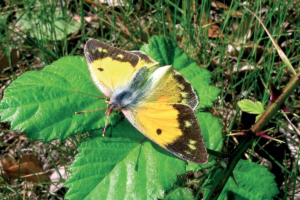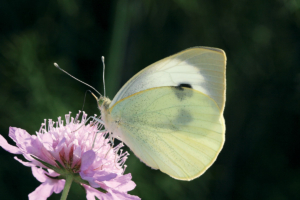BUTTERFLY GARDEN
Anthocharis cardamines
Linnaeus, 1758 – (Aurora Butterfly)
Small butterfly, widespread and relatively common throughout the country. It prefers cool, semi-open environments and prefers to fly in bushy areas at the edge of forests. The male is easily distinguished from the female by having an orange patch on the tip of the forewings. Both sexes show greenish patterns with some yellow on the underside of the wings. It is one of the first species that fly in spring and can be observed from the first days of March to May/June, when this species of butterfly completes a generation. They overwinter in the pupal stage. On Elba, the occurrence of this species seems to be the result of a recent migration from the continent. The caterpillar feeds on numerous Brassicaceae (Cardamine sp., Biscutella sp. Sisymbrium spp., Sinapis spp., Alliaria petiolata etc.).
Colias crocea
Geoffroy at Fourcroy, 1785 – (Crocea or Limoncella)
Medium-sized butterfly, widespread in Italy, which is very conspicuous due to its vivid colouring. It is a great flier, capable of flying great distances and perfectly traversing the stretches of sea that separate the islands from the mainland. On Elba this species completes at least 3 generations and flies from March until the first days of November, when the temperatures allow it. They preferred semi-open environments, wooded edges, and definitely environments where there are multiple blooms. The male is distinguished by the absence of yellow spots on the black border of the forewings. The caterpillar feeds on numerous Fabaceae, such as clover and alfalfa.
Pieris brassicae
Linnaeus, 1758 – (Cabbage white)
This butterfly (cabbage white) is the largest of the 4 species of the family Pieridae on Elba. It is a fairly large butterfly, very strong and with a very powerful flight. The butterfly is able to fly over great distances and even cross long stretches of sea. The female differs from the male in the presence of two round dark spots, which are completely absent in males. Omnipresent species throughout Italy and also widespread on Elba, where it can be observed from the plain at higher altitudes. They prefer open habitats such as uncultivated meadows, but are also commonly observed in flower gardens. The adults appear from March and fly until the month of November, where they complete several generations. They usually overwinter as a pupa. The caterpillar feeds on various species of Brassicaceae both spontaneously and in cultivation.





